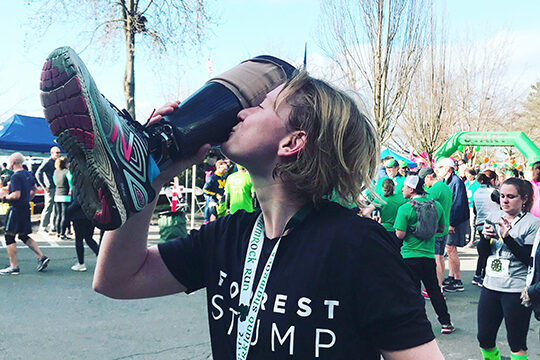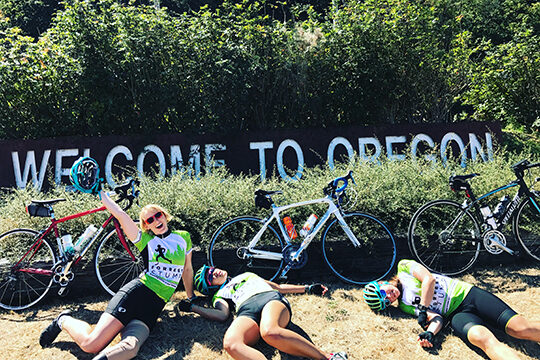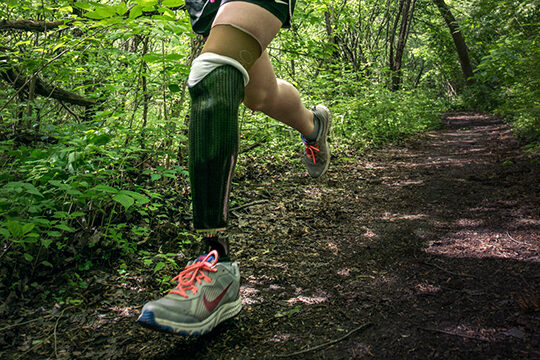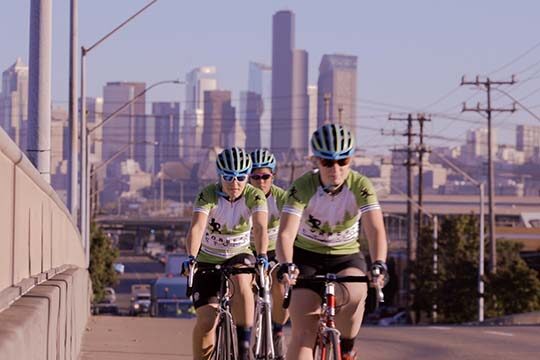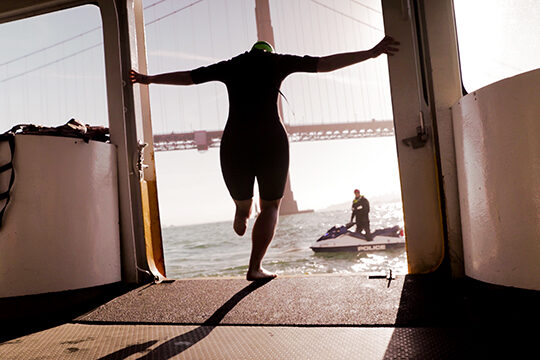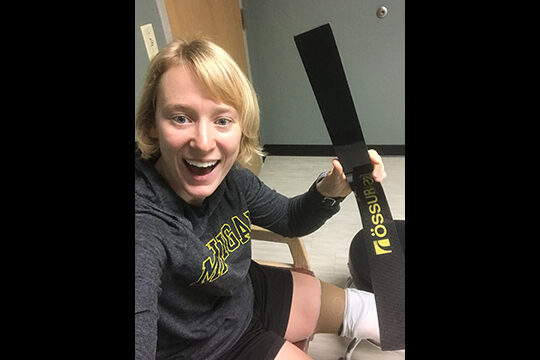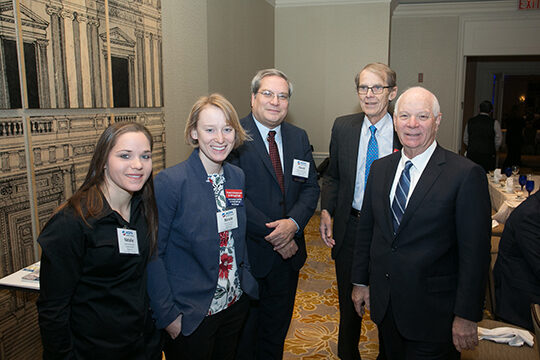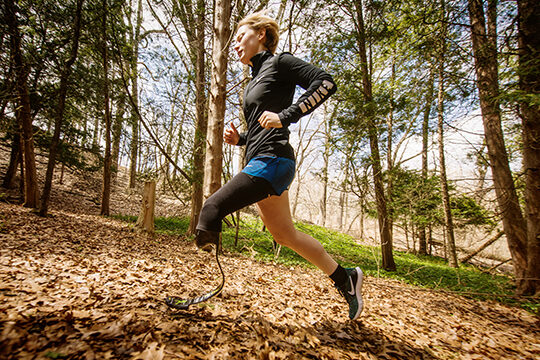Running down a dream
Nicole Ver Kuilen, BBA ’13, ran, biked, and swam 1,500 miles down the West coast to raise awareness for Forrest Stump, the nonprofit she founded to champion the rights of disabled people. “I’ve placed limits on myself,” says the athlete, who lost her leg to bone cancer when she was 10. “After this trip I realized: ‘No limits.’” The documentary about her journey, titled 1500 Miles, is in post-production. Support the film. (Photos courtesy of Nicole Ver Kuilen.)
-
Road trip
Ver Kuilen’s mission was especially challenging because her prosthesis is designed for walking. “It has no pushback or energy return,” she says, resulting in back pain and atrophy in her left leg. Ver Kuilen’s health insurance doesn’t cover a running leg. “Too often disabled people are excluded from physical activities,” she says. And too many are unable to obtain necessary technology and care.
-
Let’s Go Blue!
Ver Kuilen teamed up with training partner Kathleen Wang, BS ‘13/MS ’16, and U-M prosthetics resident Natalie Harold to complete the triathlon from Seattle to San Diego in late 2017. Brooklyn-based writing and production studio Snowday (which evolved from U-M student production company Filmic) documented the 1,500-mile journey.
-
Limbs are not a luxury
Not even halfway to her destination, Ver Kuilen’s prosthesis began to break down. Prosthetics expert Harold helped to keep it working. A “running blade,” popularized by South African Paralympian Oscar Pistorius, would enable Ver Kuilen to run without limitation. But the cost is about $20,000 and “insurance doesn’t cover those devices because they say running isn’t medically necessary.”
-
Coverage gap
The media tends to showcase high-tech advances in prosthetic technology, without explaining how few people have the money or insurance coverage to enjoy them, Ver Kuilen says. Philanthropic organizations like Challenged Athletes Foundation funded 51 percent of Paralympians worldwide in the most recent Winter Olympics.
-
Action!
Snowday filmmaker Chris Duncan, BA ’13, also is a triathlete. One of his favorite documentaries is Meet the Superhumans about some hardcore Paralympians. “This story is about Nicole pushing herself as far as she can go, and continuously running into the same obstacle,” Duncan says.
(Pictured left-right: Happy Wolverines Harold, Wang, Duncan, Ver Kuilen, and Ver Kuilen’s mom.)
-
Obstacle course
Snowday is now fundraising to complete post-production in time to submit 1500 Miles to film festivals. Says director Duncan: “We witness first-hand [Nicole’s] moments of fatigue, fear, effort, and triumph. And we personally come to understand her greatest challenge: her prosthesis.”
-
Road warriors
The cinematographer on the shoot went by the name Danger. “He’d rig himself up so he was attached to the van, and then he would hang out and come right up next to us and film us on our bikes,” says Ver Kuilen. “When we were in the Redwoods, he strapped on about 40 pounds of equipment and ran with us. He was the real athlete.”
-
Naked ambition
In San Francisco, Ver Kuilen detached her prosthetic leg to swim in a “terrifying” event titled “Shark Fest.” She lost track of her goggles and swim cap when she was distracted by a nude woman diving into the San Francisco Bay. “I thought: ‘What do I have to worry about? She’s naked.’”
-
Eye in the sky
The athletes cycled 100 miles a day, climbing as high as 76,000 feet of elevation. Snowday rented a drone camera to capture spectacular aerial footage of the team biking across the Bixby Bridge near Big Sur, Calif. Along the way, the athletes encountered roadside bulls, cattle, and tarantulas. They got lost, landed in the E/R, and swam across the Columbia River as ash fell from the tragic fire in the Gorge.
-
Stars aligned
The team timed its arrival in San Diego to coincide with a national event sponsored by the Challenged Athletes Foundation (CAF). To her surprise, Ver Kuilen received a CAF grant for a “running blade,” much like the one Oscar Pistorius used during the 2012 Olympics. “This leg is built for running,” Ver Kuilen says. “I just fly up the hills now.”
-
Next Steps
The Challenged Athletes Foundation (CAF) reports four out of five people with physical challenges who have received a CAF grant describe increased activity level and more happiness, confidence, and emotional satisfaction. Here, a thrilled Ver Kuilen shows off her new “blade.”
-
Down to business
Over the past two months, Ver Kuilen has traveled to Washington, D.C., (twice) and met with members of Congress from the states of Washington, Michigan, Minnesota, Utah, and Maryland. As a Ross student, she began thinking about an app that would allow amputees to design their prosthetic limbs. Such an app also could help researchers, technologists, and designers record and analyze data.
-
Big Picture
Ver Kuilen is the inaugural health policy & advocacy fellow for the National Association for the Advancement of Orthotics and Prosthetics. She’ll be working alongside policymakers in Washington, D.C., for 10 weeks this summer to educate, advocate, and reform health care policy around the rights of amputees and disabled people. “What’s a bigger cause in our lifetime than to make a change in someone’s rights?” she says.
(Left-right: Harold and Ver Kuilen meet with David Boone, owner, Orthocare Innovations; Tom Fise, executive director, American Orthotic & Prosthetic Assn.; and Sen. Ben Cardin (D-Md).)
-
Get out of your head
A “disability” is a very tangible limitation that one can see, says Ver Kuilen. “But honestly all of us put limits on ourselves within our minds.” Quitting her full-time job to build the nonprofit Forrest Stump was the “biggest risk I’ve ever taken, but at the same time it opened up this amazing community where I feel the most supported in my life.”

